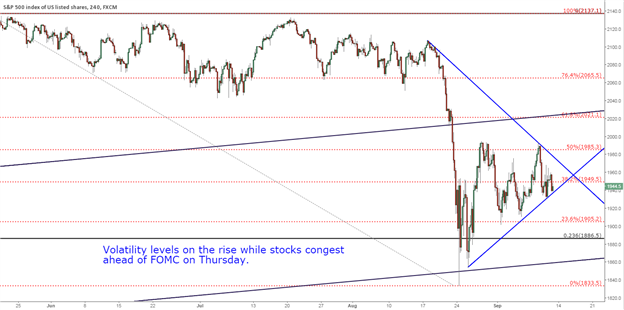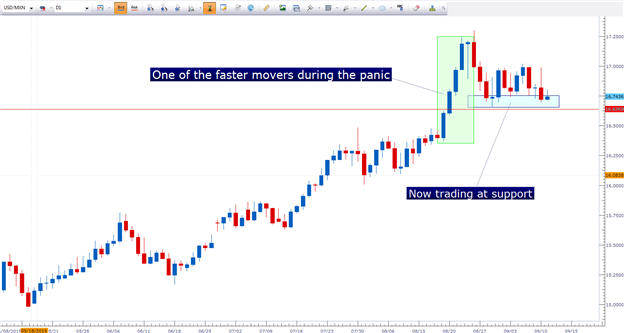Summary:
- Global stocks begin to stabilize ahead of FOMC, as volatility levels are on the rise to reflect the tumult of the past 3 weeks.
- Risk trends have aligned with the ‘risk on’ or ‘risk off’ themes based around global economic weakness.
- More attractive markets may currently be seen in long USD against emerging market currencies from Mexico or South Africa.
1. Global stocks steady ahead of the Fed: After three volatile weeks of price action across global markets, a sense of stability has begun to show over the past 24 hours as the world nears the much-awaited September FOMC meeting. While there are numerous headline-worthy events that can be assigned a primary role for the recent tumult across global markets, the uncertainty in the communication of the Central Bank representing the world’s largest national economy is likely a large driver of confusion and fear.
This has helped to bring considerable volatility across markets: Just yesterday we saw 10-day volatility levels on Japanese stocks surpass those of the Chinese equity market that’s been taking a drubbing since mid-June. And now, we’re beginning to see volatility levels on the S&P 500 surpass those of their small-cap counterparts in the Russell 2,000 index.
We’ve seen VIX surpass the value of the Russell-VIX six times since August 24th when the outsized sell-off in China began to hit the United States with aggression. Before August 24th – this had only happened twice in the prior 11 years; which of course includes the financial collapse.
This is a huge deal: Small-cap stocks, by nature, should be more volatile than their larger and significantly-more-established brethren. The fact that we are seeing so much brutal uncertainty in large-cap names just goes to show the unexpected consequences of ZIRP and the fact investors bought up shares in large-cap names due to a dearth of available options. With rates near zero, investors that would normally buy a corporate or agency bond were left without much yield. And with a surging stock market over the past 6 years that’s seen stocks trade at all-time-highs for over two-and-a-half years, buying ‘safer’ stocks in large-cap names could be seen as a very relevant way for an investor to build their portfolio in a low-yielding environment.
This is the ‘excessive risk taking’ that the Fed has talked about in the past. One of the reasons they want to raise rates is to offset this excessive risk taking. But if excessive risk taking has already taken place, and the Fed looks to embark on this hike – then the unwind of this theme means that we’ll likely see more volatility, and more pain for stock prices in the months ahead.
For now – the S&P 500 continues to congest after a rollercoaster couple of weeks. Current resistance can be seen in the 1950, 1985 and 2,000 areas.
S&P 500 moving into symmetrical wedge as we near FOMC

Created with Tradingview; produced by James Stanley
2. So, it makes sense not to hike, right? Unfortunately matters aren’t so simple. We’ve been down a similar road before, and the results weren’t very positive. The Fed has talked up policy tightening over the previous three years, only to back off once volatility in markets showed the fragility of the ‘recovery.’ The Taper Tantrum of 2013 highlights this theme, but markets were reassured when the Fed made certain to point out that the end of QE did not mean rate hikes were imminent.
For three years, some Fed officials have been circling 2015 as the target year for ‘liftoff.’ Consistency is a fairly important trait in a Central Bank, and after the previous back-tracking that we’ve seen from the bank towards rate hikes, failing to hike again after numerous reassurances throughout the year would only serve to erode that confidence even more. And if we do happen to spiral into a global recession, that additional loss of confidence only makes the Central Bank more ineffective in trying to combat deflationary forces. The Fed has said that they’re ‘data dependent,’ and that the first rate hike doesn’t mean that second is coming anytime soon; so they’ve already tried to soften the blow of the impact from that first hike.
The United States has begun to see inflationary forces. The earmarks of ‘data dependency’ that the Fed has given for ‘liftoff’ have already been met, long ago. If they don’t hike, they risk losing confidence; and if, by chance, markets trade higher they run the risk of stoking even more excessive risk taking. This is how bubbles get built, if they aren’t built already. If they do raise the Fed runs the risk of putting the global economy in a tailspin, as nearly every emerging market in the world is facing pressure and both Europe and Asia teeter on the brink of economic disaster.
The worst-case-scenario here is that if the Fed does raise, and if the global economy does lurch lower – they may have to backtrack with even more ‘especially accommodative policy.’ This happened in Europe in July of 2011 when Jean-Claude Trichet hiked rates, only to reverse the decision later in the year as the European Debt Collapse began shortly after this rate hike.
Add to this the varying commentary that we’ve received from various Fed members, including the hawkish tone that Ms. Yellen took during her congressional testimony earlier in the summer, and confusion reigns supreme around this FOMC decision.
This is shaping up to be one of the most interesting Fed meetings in years. Currently, expectations are 28% for a hike September, 39.5% for October and 58.9% for December.
3. Most attractive markets to be positioning around right now: Much is up-in-the-air with this FOMC decision on the docket for next week, and many markets have begun to correlate along with risk trends. The ‘risk on’ and ‘risk off’ type of environment from 2012-2013 is back in markets where risky assets are pricing roughly in-line with each other.
For playing ‘panic’ or ‘risk off’: Long Yen against almost any currency, long EURUSD (unwind), short stocks, particularly the Nikkei (JPN225), S&P 500 (SPX500), Hong Kong (HKG33)
For playing ‘everything will be ok’ or ‘risk on’: Short EURUSD, Short AUDUSD, Long USDCAD, Short Gold and Long Stocks (the larger the move down over the past few weeks, the more attractive the market for playing this theme).
But for those that want to try to avoid the risk on/off theme, an attractive area could be seen in emerging markets; because no matter what happens next week, emerging markets are likely in for some additional pain as the impact of low oil prices begin to show in the economic data. The downgrade of Brazilian debt to junk status yesterday highlights how drooping commodity prices can show up in future data prints; which can, then, bring on further economic weakness.
Of particular interest are short Mexican Peso and short South African Rand against the US Dollar. Both pairs put in exuberant runs higher as panic was setting in the environment, but this merely hastened their previous up-trends. With a sense of stability coming in markets over the past week, this has helped these setups move down to more reasonable prices to the point of offering attractive risk-reward ratios. Below is the current setup on USDMXN.
USD/MXN now trading at support with an attractive risk-reward ratio

Created with Marketscope/Trading Station II; prepared by James Stanley
Written by James Stanley of DailyFX; you can join his distribution list with this link, and you can converse with him over Twitter @JStanleyFX.






